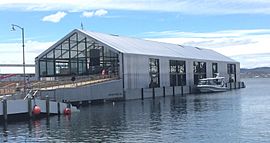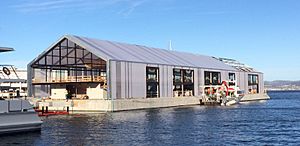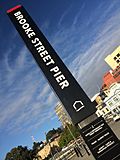Brooke Street Pier facts for kids
Quick facts for kids Brooke Street Pier |
|
|---|---|

Brooke Street Pier, January 2015
|
|
| General information | |
| Status | Complete |
| Address | Franklin Wharf |
| Town or city | Hobart |
| Country | Australia |
| Coordinates | 42°53′05″S 147°19′58″E / 42.88472°S 147.33278°E |
| Elevation | Sea level |
| Construction started | April 2014 |
| Opened | 21 January 2015 |
| Cost | A$13 million |
| Dimensions | |
| Weight | 4,200 t (4,134 long tons) |
| Other dimensions | 80 m × 20 m (262 ft × 66 ft) |
| Technical details | |
| Floor count | 4 |
| Design and construction | |
| Architect | Robert Morris-Nunn |
| Architecture firm | Circa Morris Nunn |
| Developer | Brooke Street Pier Development Corporation |
| Structural engineer | Gandy and Roberts Pty Ltd |
| Services engineer | Cundall |
| Civil engineer | Gandy and Roberts Pty Ltd |
| Other designers | Fred Barrett Yacht Design |
| Main contractor | Fairbrother |
The Brooke Street Pier is a special floating building located in Hobart, Tasmania, Australia. It sits on the water at Sullivans Cove, which is a busy waterfront area. Built between 2014 and 2015, it cost about A$13 million. When it was finished, it weighed around 5,300 tonnes, making it Australia's largest floating building at the time! It's connected to the land at Franklin Wharf. The pier is mainly a ferry terminal, but its architect also calls it a "tourism transport hub" because it helps many visitors explore the area.
Contents
A Look Back: The Pier's Story
A pier has been at Brooke Street since the 1820s. The first recorded upgrade happened in 1879. Back then, it was about 45 metres long and 15 metres wide. It was also known as Monarch Pier.
These older piers were not designed for huge amounts of cargo. They were different from the bigger piers further north.
In the 1960s, these piers were replaced with smaller jetties. They became popular for tourist boats. A company called Navigators has been running tours from Brooke Street Pier since 1951.
Why a New Pier Was Needed
The number of ferry passengers in Hobart grew a lot. It went from 90,000 in 2010 to over 300,000 in 2014. The old pier simply couldn't handle so many people. One ferry operator even said the pier was "about to fall in the river."
The Government of Tasmania asked companies to suggest ideas for a new Brooke Street Pier. The first time was in 2007. A group of companies, including Federal Hotels, suggested building a hotel along with new wharves. However, this design didn't fit the area, so the hotel plan was cancelled in 2009.
A second attempt to redevelop the pier began in 2010. The plan was submitted to the Hobart City Council in April 2012. In June 2012, the state and federal governments agreed to give A$5 million for the project. Construction was officially announced in December 2013.
Building the Floating Pier
Construction started in April 2014. It was built at Incat, a company known for making ferries. Incat is located at Prince of Wales Bay.
In November 2014, the partly finished building, weighing 4,000 tonnes, was towed 8 kilometres down the river. It was then placed in its final spot. It's held in place by a special system called Seaflex, which anchors it to the seabed.
Design and Features
The structure is 80 metres long and 20 metres wide. It has four levels. One concrete level sits 4 metres below the water. This basement holds things like kitchens, storage, toilets, and a special heating and cooling system that uses sea water.
The three levels above the water are covered in a special see-through material. This material has tiny particles inside that make it light and help keep the building warm. It also has LED lights that make the pier glow at night.
Eco-Friendly Design
The building was designed with the environment in mind. The special outer covering lets in natural light and helps with heating. The heating and cooling system uses the constant temperature of the sea water, which saves energy.
Because it's a floating building, it won't be affected by rising sea levels. The unique mooring system allows the pier to move up and down with the tides while staying steady. The roof design looks similar to other buildings in Sullivans Cove. This helps it fit in with the area's history as a busy port.
What You'll Find Inside
The pier is mainly a ferry terminal. The main ferry companies here are Navigators, which runs the MONA ferry, and Peppermint Bay Cruises.
There's also a public area and a market. Here, other tourism businesses and sellers of Tasmanian products set up stalls. You can find local seafood, cheese, wine, and whisky. When ferries aren't running, the terminal level can be used for events, holding up to 1,200 people.
Shops and Eateries
The biggest permanent business is a restaurant called The Glass House. There's also a café called "Adrift" and an espresso bar called "Bright Eyes."
Many local businesses sell their products here. These include Valhalla Icecream, Huon Aquaculture, TasmanianMarket, Grandvewe Cheeses, Moorilla Estate, and McHenry Distillery. The pier also offers free Wi-Fi for visitors.




